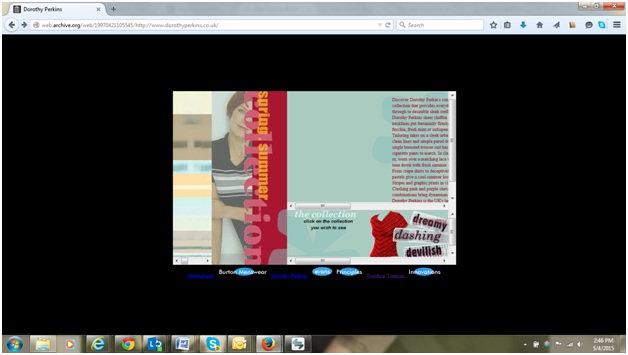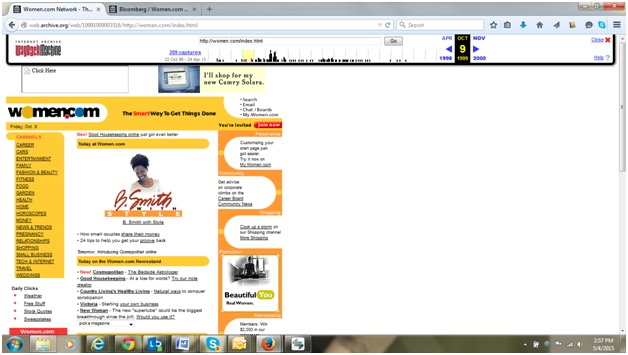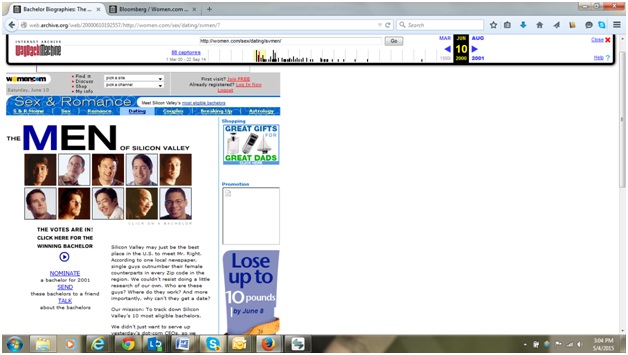I fondly recall my very first URL - it wasn't a GeoCities site, though that would follow along in due course - but just the few KB (indeed) of web space every postgrad student was allotted by the Institute of Archaeology, University College London. Unfortunately, there's no trace of the content now, though the URL lives on as a 'not found' snapshot in the Wayback Machine. It's a shame, because while I don't recall falling prey to blink tags or other early web missteps, it did have a very vivid teal-and-yellow tiled background that coincidentally matched a dress I'd bought at Topshop (more on them below), and I wouldn't mind seeing either one again. So, while my first foray into web development doesn't exist anymore (a bit ironic, given that archaeologists love preservation, digital and otherwise), at least I still remember this: http://www.ucl.ac.uk/~tcrnlag/index.html
But thanks to the Internet Archive's drive to save GeoCities - and, of course, a vast galaxy of sites beyond - some of my early work, both professional and otherwise, does live on; so many websites captured from the Time Before CMS and DAM. After running out of space on my UCL account, I set up shop on GeoCities with a 'hotlist' related to my MA dissertation - those were a big deal circa '95-'96, since search engines weren't especially powerful, and even the site that would become Yahoo, Jerry and David’s Guide to the World Wide Web, was human-curated back then. I also built a GeoCities site for one of my favorite bands, David Devant and his Spirit Wife, and employed what seemed like a pretty cutting-edge Java applet, though alas, the applet hasn't survived the freezing process. And I nearly forgot until the recent 20th anniversary that I used to help out on The Craggy Island Examiner, a Father Ted fansite. The site was powered by basic HTML, visible tables and not a few pints at a pub near Waterloo where we held 'editorial meetings,' and once a mini-Tedcon, circa 1996. But that bit of volunteer work did help lead to my first actual web job, at Time Out in January of 1996.
The site was a one-man operation when I started, so it was perhaps noteworthy that the web team immediately reached gender parity when I joined (though we did have some occasional help from another gentleman/former member of Hawkwind later). I believe one reason I got the job was simply because I emailed my resume and links to my 'experience' in response to the job posting; it was mentioned in the interview that no one else had taken that radical step. Time Out was a fantastic place to work in the mid-1990s - I got a free copy of the magazine each week, I got invited to book launch parties, occasional press passes and the inside scoop on some of my favorite bands. All I had to do was update the site each week - all the global sites (such as they were then, imagemaps and all) were run from London. And when I saw it again, I actually remembered dropping in that note about Budapest. Midway through my tenure at Time Out, we brought in a more structured layout with 'complex' tables - though still no sign of a CMS or anything approaching one.
I moved on to work for an agency that built sites for clients like Christies, Condé Nast and the Evans Group (retail clothing shops like Dorothy Perkins, Evans, Topshop and so on), where heavily-sliced images, complex tables and frames - and getting them to line up in competing browsers - became the bane of my existence. But I do fondly recall the spinning 'D' on the Debenhams site; that was also quite exciting back then. And this particular Dorothy Perkins page was a nightmare to build - so I'm glad it still exists. Unfortunately the early Topshop pages seem to be long gone, though it was fun working on something for which you were the target audience.
But the real mother lode (as it were) of my early web work comes from the Internet Archive's snapshots of my career at Women.com in Silicon Valley. As the web nerd in charge of the homepage, both for Women.com itself as well as many of its affiliated sites like WomensWire, Prevention and more, there's a great deal more preserved. I moved back to the US in late 1998 (when the site looked like this) , and, having turned down a wildly underpaid job at Yahoo (yes, there were stock options, but you couldn't have paid rent in the meantime), I commenced work at Women.com. It was an exciting time to be there, and at first, there was a lot of 'smart content' aimed at women - not in the modern sense of 'smart content' of course, but there was a lot of information on careers, finances and health. It wasn't quite Bust Magazine territory, but it wasn't as far off as it would be later. I was tasked with building the redesigned site in 1999 - now everything was yellow - but what's most interesting to see is what remains of the content - features like the Bloomberg/Women.com 30 Index, tracking the success of woman-led companies on Wall Street; the 'first ever online presidential primary for women' (spoiler alert: Al Gore won) and the Men of Silicon Valley ('high-tech's hottest bachelors!'). So yes, that was a Thing That Happened.
There's much more to dig and record where that came from; I was at Women.com until 2001, when, with the writing on the wall for pure content sites, I moved on to Juniper Networks where 'no layoffs' were promised - when that turned out not to be true, I went to Hewlett-Packard, where Carly Fiorina was on what seemed to be a mission to destroy the entire company, largely from the recording studio next to my desk, but that's a story for another time
This post also appears on Medium.



